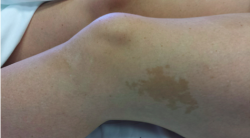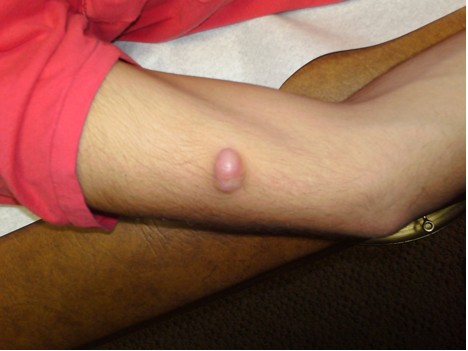CORRECT DIAGNOSIS:
Baboon Syndrome
DISCUSSION:
Baboon syndrome is a benign self-limiting type IV drug sensitivity reaction that was first described in 1984 by Anderson et al (1) . It presents with a very characteristic rash in the gluteal and intertriginous areas with symmetry of lesions hours to two days after exposure to the offending agent. Mucosal involvement is not present and involvement of the face and palmoplantar surfaces are rare. Atypical features that have been reported include pustules, papules, or bullae overlying a flexural exanthema as seen in our patient (3-7).
It is unknown why the rash presents in flexural surfaces. Two theories have been proposed. One suggests it’s a form of recall phenomenon from a previous unrelated dermatitis (8) or another theory suggests that metabolites of the causative agent are excreted preferentially from eccrine glands found in flexures (9). However, this doesn’t account for the exanthema in the gluteal region, which is the main diagnostic criterion for baboon syndrome.
Antibiotics, particularly beta-lactams, account for the majority of cases of baboon syndrome. Other drugs implicated include antihypertensives, radiocontrast media, nickel, mercury, omeprazole, clozapine, roxithromycin, ceftriaxone, intravenous immunoglobulins, chemotherapeutic agents and biologics. To our knowledge, methamphetamines have not been documented as a cause of baboon syndrome. This case is particularly challenging because of the uncertainty of the methamphetamine makeup. According to Winnicki and Shear, there have been two reported cases of baboon syndrome after exposure to pseudoephedrine (10). This could be the underlying etiology of the baboon syndrome in this case, although it is known that methamphetamine can be made with lighter fluid, drain cleaners, anhydrous ammonia, ethyl ether, and acetone to name a few (11).
Diagnosis is generally made clinically however sometimes with the aid of a biopsy. Controller drug-provocation testing is the gold standard for the diagnosis however rarely used.
The condition is self-limiting however topical and parenteral steroids have been shown to hasten recovery and provide symptomatic relief (12-13). Recovery may take up to 3 weeks.
TREATMENT:
The patient was prescribed a low dose 15-day taper of prednisone and triamcinolone 0.1% ointment which was applied topically to the affected areas twice daily for no longer than two weeks.
REFERENCES:
1. Andersen KE, Hjorth N, Menne T. The baboon syndrome: systemically-induced allergic contact dermatitis. Contact Dermatitis 1984; 10:97–100.
2. Häusermann P, Harr TH, Bircher AJ. Baboon syndrome resulting from systemic drugs: is there strife between SDRIFE and allergic contact dermatitis syndrome? Contact Dermatitis 2004; 51:297–310.
3. Hembold P, Hegemann B, Dickert C, et al. Symptomatic ptychotropic and nonpigmenting fixed drug eruption due to cimetidine (so-called baboon syndrome). Dermatology 1998; 197:402–403.
4. Gordon E. Baboon syndrome caused by salasate. J Drugs Dermatol 2002; 1:66.
5. Sans V, Jouary T, Hubiche T, et al. Baboon syndrome induced by cetuximab. Arch Dermatol 2008; 144:272–274.
6. Ferreira O, Mota A, Morais P, et al. Symmetrical drug-related intertriginous and flexural exanthema (SDRIFE) induced by telmisartan-hydrochlorothiazide. Cutaneous Ocular Toxicol 2010; 29:293–295.
7. Elmariah SB, Cheung W, Wang N, et al. Systemic drug-related intertriginous and flexural exanthema (SDRIFE). Dermtol Online J 2009; 15:3.
8. Wolf R, Orion E, Matz H. The Baboon syndrome or intertriginous drug eruption: a report of eleven cases and a second look at its pathomechanism. Dermatol Online J 2003;9:2.
9. Valks R, Buezo GF, Dauden E, et al. Eccrine squamous syringometaplasia in intertriginous areas. Br J Dermatol 1996;134:984–6.
10. Winnicki, M. Shear, Neil. A Systematic Approach to Systemic Contact Dermatitis and Symmetric Drug-Related Intertriginous and Flexural Exanthema (SDRIFE). Am. J Clin Dermatology 2011. 12(3): 171-180
11. Mosier, S MD. Meth Lab Components. Kansas Department of Health and Environment. http://www.kdheks.gov/methlabs/meth_lab_components.html. Oct. 26, 2015
12. Elmariah SB, Cheung W, Wang N, et al. Systemic drug-related intertriginous and flexural exanthema (SDRIFE). Dermatol Online J 2009;15:3.
13. Miyahara A, Kawashima H, Okubo Y, et al. A new proposal for a clinical-oriented subclassification of Baboon syndrome and a review of Baboon syndrome. Asian Pac J Allergy Immunol 2011;29:150–60.




